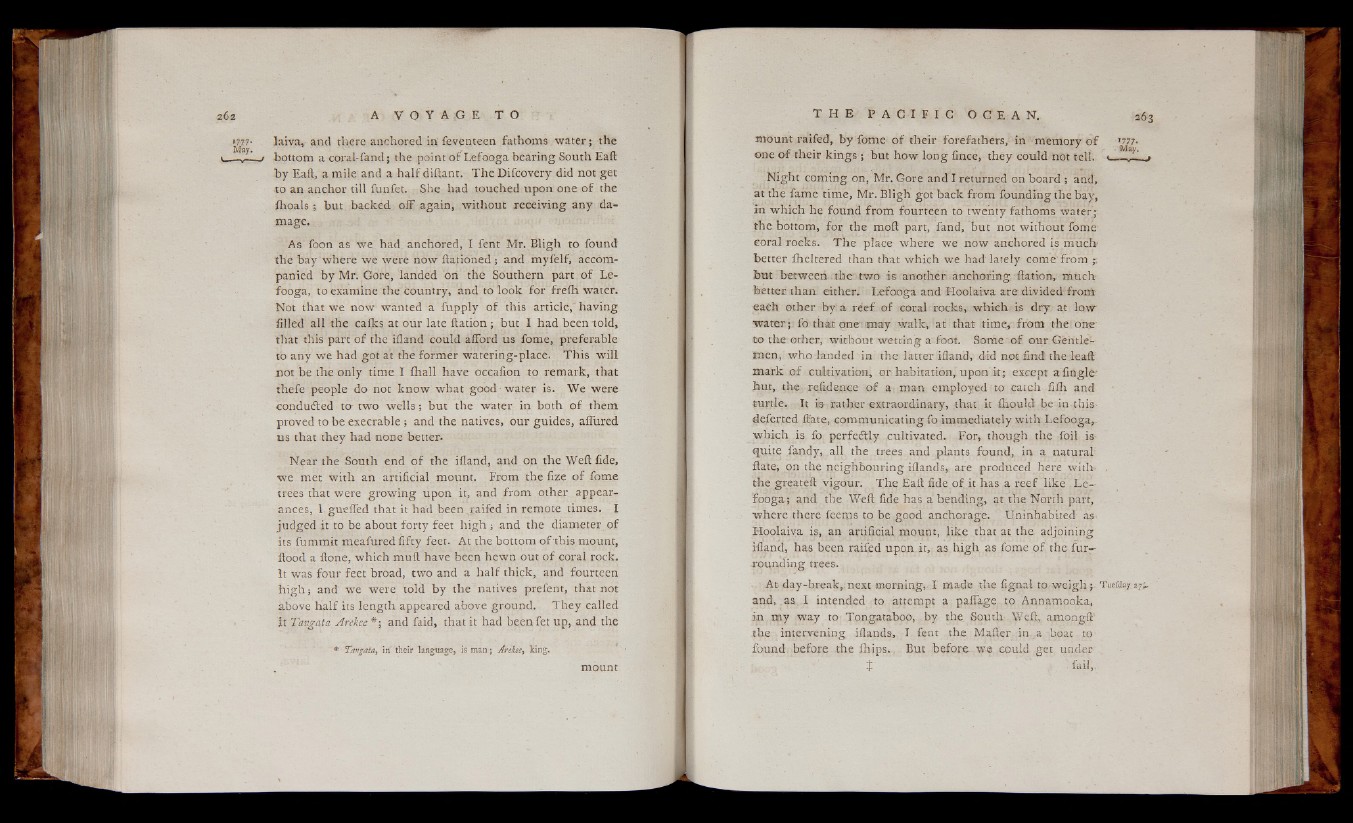
>777- laiva, and there anchored in feventeen fathoms water; the
—,-1_» bottom a coral-fand; the point of Lefooga bearing South Eaft
by Eaft, a mile and a half diftant. The Difcovery did not get to an anchor till funfet. She had touched upon one of the
ihoals ; but backed off again, without receiving any damage.
As foon as we had anchored, I fent Mr. Bligh to found the bay where we were now ftationed ; and myfelf, accompanied
by Mr. Gore, landed on the Southern part of Lefooga,
to examine the Country, and to look for freih water.
Not that we now wanted a fupply of this article/ having
filled all the calks at our late ftation; but I had been told, that this part of the illand could afford us fome, preferable
to any we had got at the former watering-place. This will
not be the only time I fhall have occafion to remark, that
thefe people do not know what good water is. We were
conduced to two wells; but the Water in both of them proved to be execrable ; and the natives, our guides, allured us that they had none better.
Near the South end of the illand, and on the Weft fide,
we met with an artificial mount. From the lize of fome trees that were growing upon it, and from other appearances,
1 gueffed that it had been raifed in remote times. I judged it to be about forty feet high ; and the diameter of
its fummit meafured fifty feet. At the bottom of this mount, flood a ftone, which mull have been hewn out of coral rock. It was four feet broad, two and a half thick, and fourteen
high; and we were told by the natives prefent, that not
above half its length appeared above ground. They called
it Tangata Areku Eg and faid, that it had been fet up, and the
* 'Tangata^ in their language, is man j Arefoe, king. mount
mount raifed, by fome of their forefathers, in memory of ’ 7 7 7 . one of their kings ; but how long lince, they could not tell. * -T _r
Night coming on, Mr. Gore and I returned on board ; and,
at the fame time, Mr. Bligh got back from founding the bay,
In which he found from fourteen to twenty fathoms water; the bottom, for the moil part, fand, but not without fome eoral rocks. The place where we now anchored is much'
better fheltered than that which we hadlately come from s but between.the two is another anchoring ftation, much- better than either. Lefooga and Hoolaiva are divided from each other by a reef of coral rocks, which is dry at low
water; fo that one: may walk, at that time, from the-one
to the-other, without wetting a foot. Some of our Gentlemen,
who landed in the latter illand, did not find the.leaft
mark of cultivation, or habitation, upon hut, the reftdence of a man employed itto; ceaxtccehp tf iai hA nagnled-
turtle; It is rather extraordinary, that it fhould be in this-
deferred itate, communicating fo immediately with Lefooga,. which is fo perfectly cultivated. For, though the foil is quite fandy, all the trees and plants found, in a natural ftate, on the neighbouring iflands, are produced here with- the greateft vigour. The Eaft fide of. it has a reef like Ler-
fooga; and the Weft fide has a bending, at the North part, where there feems to be good anchorage. Uninhabited as-
Hoolaiva is, an artificial mount, like that at the adjoining
ifland, has been raifed upon it, as high as fome of the fur- rounding trees.
At- day-break,.next morning,. I made the fignal to weigh ; Tueffl«r,a#, and, as I intended to attempt a palla.ge to Annamooka,
in my way to- Tongataboo, by the South Weft, amongft
the intervening iflands, I fent the Mailer in a boat to found before the fhips.. But before we could get under
$ 1 fail/